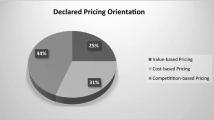Abstract
Value-based pricing is by many companies as well as in academia perceived as the preferred pricing model. The pricing literature includes a long-standing debate on pricing authority and centralized pricing authority can be associated with value-based pricing strategies. A critical success factor for value-based pricing is customer value assessment, and many companies have experienced challenges in implementing value assessment to support its value-based pricing. This paper outlines how centralized versus delegated value assessment responsibility depends on the organization’s value creation character and the variations in value in use for different customers within individual market segments. Based on the integration of literature on pricing and value configurations we propose a framework which we then exemplify by four illustrative cases for which data were gathered by semi-structured interviews. By considering the implications of value creation models on value assessment following our framework we contribute to the understanding of how value assessment responsibilities should be assigned for firms working with value-based pricing.





Similar content being viewed by others
References
Andersson, L. (2013) Pricing capability development and its antecedents. Dissertation. Lund Studies in Economics and Management, Lund University, Lund.
Dolan, R.J. and Simon, H. (1996) Power Pricing: How Managing Price Transforms the Bottom Line. New York: The Free Press.
Dutta, S, Zbaracki, M and Bergen, M. (2003) Pricing process as a capability: A resource-based perspective. Strategic Management Journal 24(7): 615–630.
Frenzen, H., Hansen, A.K., Krafft, M., Mantrala, M.K. and Schmidt, S. (2010) Delegation of pricing authority to the sales force: An agency theoretic perspective of its determinants and impact on performance. International Journal of Research in Marketing 27(1): 58–68.
Hinterhuber, A. (2004) Towards value-based pricing—An integrative framework for decision making. Industrial Marketing Management 33:765–778.
Hinterhuber, A. (2008) Customer value-based pricing strategies: Why companies resist. Journal of Business Strategy 29: 41–50.
Hinterhuber, A. and Liozu, S. (2012) Is it time to rethink your pricing strategy? MIT Sloan Management Review 53(4): 68–77.
Johansson, M. (2013) Pricing processes in fast paced business to business settings. In A. Hinterhuber and S. Liozu (eds.) Innovation in Pricing. New York: Routledge.
Johansson, M. and Andersson, L. (2012) Pricing practices and value creation logics. Journal of Revenue and Pricing Management.
Johansson, M. and Jonsson, A. (2012) The package logic: A study on value creation and knowledge flows. European Management Journal 30(6): 535–551.
Johansson, M., Keränen, J.K., Hinterhuber, A., Liozu, S., and Andersson, L. (2015) Value assessment and pricing capabilities—How to profit from value. Journal of Revenue and Pricing Management 14(3): 178–197.
Joseph, K. (2001) On the optimality of delegating pricing authority to the sales force. The Journal of Marketing 65(1): 62–70.
Lal, R. (1986) Delegating pricing responsibility to the sales force. Marketing Science 5(2): 159–168.
Lampel, J. and Mintzberg, H. (1996) Customizing customization. Sloan Management Review 38: 21–30.
Lazear, E.P. (2015) The impatient salesperson and the delegation of pricing authority. Nber Working Paper Series. Working Paper 20529.
Mitchell, V. and Wilson, D. (1998) Balancing Theory and Practice. A Reappraisal of Business-to-Business Segmentation. Industrial Marketing Management 27:429–445.
Nagle, T.T. and Hogan, J.E. (2006) The Strategy and Tactics of Pricing: A Guide to Growing More Profitably. 4th edn. Upper Saddle River, NJ: Pearson Education.
Nagle, T.T. and Holden, R.K. (2002) The Strategy and Tactics of Pricing: A Guide to Profitable Decision Making. 3rd edn. Upper Saddle River, NJ: Pearson Education.
Pigou, A.C. (1920) The Economics of Welfare. London: Macmillan.
Rackham, N., DeVincentis, J.R. and NetLibrary, I. (1999) Rethinking the Sales Force: Redefining Selling to Create and Capture Customer Value. New York: McGraw-Hill.
Shapiro, B.P. (1977) Product policy in different types of industrial companies. HBS Teaching. Note 9-577-074.
Shapiro, C. and Varian, H. (1999) Information Rules. Boston, MA: Harvard Business School Press.
Sharma, D. (1987) Manufacturing strategy: An empirical analysis. Unpublished PhD dissertation. Ohio State University.
Smith, G.E. and Nagle, T.T. (2005) A question of value. Marketing Management 14(4):38–43.
Stabell, C.B; Fjeldstad, Ø.D. (1998) Configuring value for competitive advantage: On chains, shops, and networks. Strategic Management Journal 19: 413–437.
Stephenson, P.R., Cron, W.L. and Frazier, G.L. (1979) Delegating pricing authority to the sales force: The effects on sales and profit performance. The Journal of Marketing 43(2): 21–28.
Teece, D. (2010) Business models, business strategy and innovation. Long Range Planning 43: 172–194
Thomas, G.A. (2011) Typology for the case study in social science following a review of definition, discourse, and structure. Qualitative Inquiry 17(6): 511–521
Thompson, J.D. (1967) Organizations in Action. New York: McGraw-Hill.
Ulaga, W. and Chacour, S. (2001) Measuring customer-perceived value in business markets a prerequisite for marketing strategy development and implementation. Industrial Marketing Management 30: 525–540
Ulaga, W. (2003) Capturing value creation in business relationships: A customer perspective. Industrial Marketing Management 32: 677–693.
Vargo, S. and Lusch, R. (2016) Evolving to a new dominant logic for marketing. Journal of Marketing 68(1): 1–17.
Author information
Authors and Affiliations
Corresponding author
Rights and permissions
About this article
Cite this article
Johansson, M., Olsson, G. & Andersson, L. Value creation character and value assessment responsibility. J Revenue Pricing Manag 16, 56–75 (2017). https://doi.org/10.1057/s41272-016-0052-2
Received:
Revised:
Published:
Issue Date:
DOI: https://doi.org/10.1057/s41272-016-0052-2




